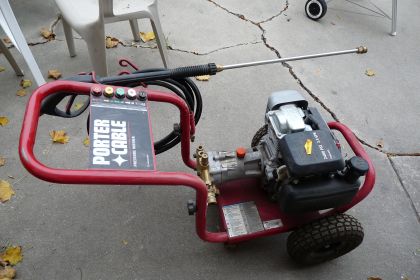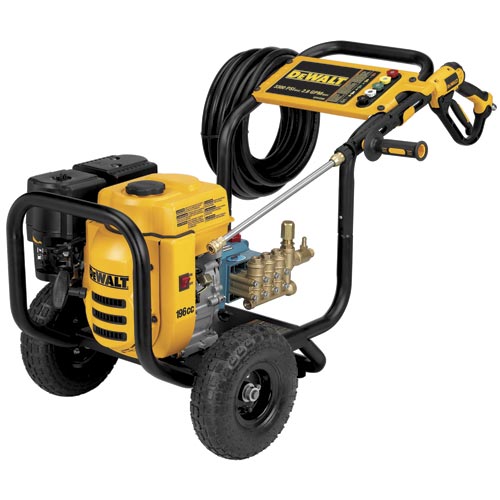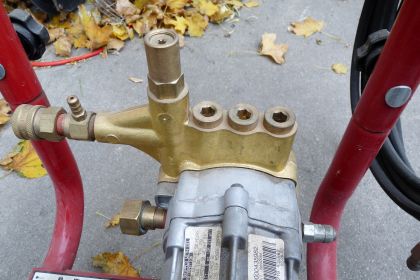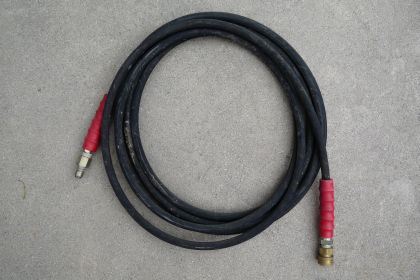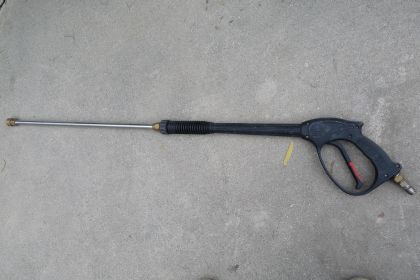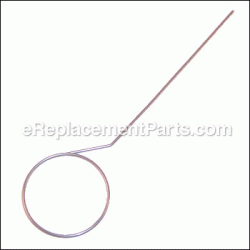Why Read This Article?
Finish Nailer Repair - Replacing the Driver Guide (Ridgid Part # 79004001022)
Article Breakdown
Finish Nailer Repair - Replacing the Driver Guide (Ridgid Part # 79004001022)
The Porter Cable PCH2401 Pressure Washer
Even though investigating a pressure washer performance issue can be a little tedious, getting to the bottom of the problem is just a matter of time and eliminating possibilities with a thorough inspection.
This article provides information that most pressure washer owners need to understand about how pressure washers work. It also explains steps for diagnosis of major pressure washer symptoms, starting with the most likely, most easily fixed possibilities. And it also explains how to prevent most washer problems.
The truth is that some pressure washer service issues just require professional help, and sometimes diagnosis can be next to impossible. But, the steps in this article will help users quickly determine if their diagnosis has hit a dead end, if it needs to go to a shop, or if it's just something simple like cleaning a valve.
How Pressure Washers Work
Most pressure washer owners really love their pressure washer, which shouldn't be surprising. Pressure washers can easily take care of what would otherwise be tedious, backbreaking, hard-to-reach, or impossible cleaning jobs, and they use minmal water to do it.They're actually rather remarkable tools.
However, pressure washer systems are also very sensitive. Any kind of obstruction or addition of air can sharply decrease a washer's performance and/or damage parts. On top of that, most problems present with the same symptoms.
Being familiar with and understanding the major parts of a pressure washer system is very important to diagnose washer problems.
The DeWALT DPD3300 Pressure Washer Here is a short list of the major parts of a pressure washer common to most designs:
1. Water enters the system's inlet, though its inlet hose and inlet valve.
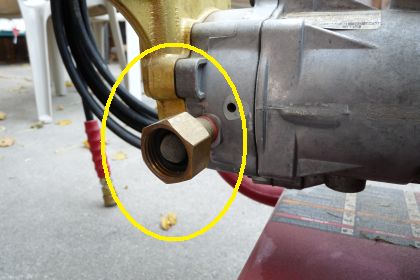
- Most homeowner models are fitted for a garden hose to attach to the inlet as a water supply.
- Inlet connections must be tight enough to prevent air from entering the system.
- It is very important that the pressure washer receives the right amount of water flow from its source (see user manual).
2. Before entering the pump, water is filtered through an intake filter or screen.
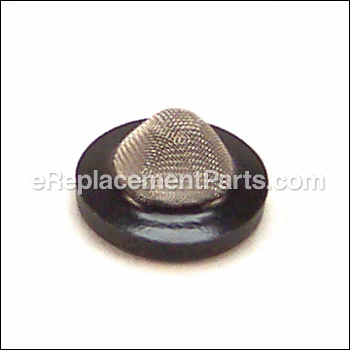
- Intake filters prevent dirt and other obstructions from entering the pump where they could easily damage parts and decrease performance.
- The best filters are clear, so that they can be easily inspected.
- Pressure washer intake filters can be simple screen filters or more complicated filtering systems.
- Buying the best filter that is specified for a pressure washer is a good way to keep it running smoothly.
3. After being filtered, the water will usually pass through a regulator (regulator valve).
- Regulator valves help to control the flow and pressure of water into the pump.
4. Water enters the power pump.
- Power pumps are well-engineered components.
- Power pumps consist of a crankcase that attaches to the motor and a manifold.
- Power pumps are also designed several different ways, but each will include a number (which varies) of inlet, check, and outlet valves that work together to pass and pressurize water.
- About 90% of the time, a pressure washer problem will not be caused by the pump.
5. When the pressure washer gun trigger is depressed, the pressurized water leaves the power pump and exits through the outlet valve and outlet hose.
6. From the outlet hose, the water passes through the pressure washer gun and out the pressure nozzle.
When a pressure washer is in operation but the gun trigger is not depressed, something must be done with the pressurized water coming out of the power pump, since it's not exiting the system:
- Guns and nozzles are the most commonly replaced parts of a pressure washer system.
- Luckily, most (but not all) washer problems occur in the gun or nozzle, which are both easily accessible and easy to replace.
7. Unloader valves are another important part of every pressure washer.
Those are the major pressure washer parts, and understanding what they do is pretty simple enough. The catch is that pretty much everything has to go just right in a pressure washer for it to perform up to its design specifications. Seals and valves must stay air-tight and clean, the water path must remain completely unobstructed, the washer must be receiving enough water from its water source (usually 1 GPM more than its rating), lubricated parts must stay lubricated, and the oil needs to be fresh and and full.
- They redirect water from the pump when water is not exiting the system.
- This way, pressure does not built up too much in the pump system.
- Instead, it is redirected through an unloader hose and recycled through the power pump again.
- Unloader valves are usually an upright assembly attached to the power pump.
- They also have an adjustable spring that can slightly control how much pressure it will allow to build up in the power pump before redirecting water.
Maintaining a pressure washer to prevent performance problems goes a long way, but, eventually, a pressure washer is going to get an obstruction, air in its system, or see some wear on its parts. [Back to top]
Pressure Washer Performance Killers Before moving on to diagnosing specific symptoms, it might help just to list the intrusions and conditions that kill a power washer's performance.
Lack of Power-
Like any other machine, the wrong power supply will greatly effect its use. Power supply is the first and easiest thing to check when water pressure drops.
Insufficient Water Flow-
Each pressure washer is rated to operate at a specific rate of water flow. This is usually expressed in GPM (gallons per minute). When not sure, users should check that they are operating their pressure washers at the correct GPM by checking their owner's manual. Sometimes a performance issue is that simple.
Dirt/Build-Up-
Any kind of dirt or build-up in a pressure washer is bad. This means in the intake hose, around the intake valve, around the regulator, in the pump valves, around the unloader, in the unloader hose, in or around the outlet hose and outlet valve, in the gun, and in the gun nozzle. In other words, the entire path of water through the machine must be dirt and build-up free.
Gunky valves and valve O-rings will decrease performance and increase wear on components. If dirt somehow gets into the pressure pump, the pressurized conditions make it easy for the pump to be internally damaged.
All in all, completely flushing a pressure washer before and after each use will save many problems with dirt in the system. And just a few minutes cleaning valves will help a washer run its best.
Air in the System-
Air might even be worse for a pressure washer system than dirt. Air in the system will cause sputtering pressure at the exit end of the gun, among other things.
If air gets into the pressure pump, the pressure can cause little mini "explosions" that effectively chip away at the inside of the pump.
Air can easily be removed from the pressure washer system by "bleeding" it (see below).
Obstruction-
Any kind of other obstruction along the path of the water should be noticeable right away due to a drop in performance. Check for grains of sand in valves, bent or kinked hoses, material in the nozzle, and excessive debris in the intake filter.
Wrong Component/Part-
Pressure washer parts must match the rating for that washer's specs in order for it to run correctly. That includes the regulator, the unloader, the gun, and the nozzle.
Mismatching these or any other part will almost always cause performance problems right away.
Leaks-
A leak in a hose, a valve, around an O-ring, in the gun, or anywhere else along the water path will drop the water pressure.
Leaking hoses and guns should be replaced. If cleaning valves and O-rings does not stop leaks, they should also be replaced.
Incorrectly-adjusted Unloader-
Remember how that unloader valve has an adjustable spring? Tightening or loosening this spring will set the threshold pressure at which an unloader will begin diverting water away from the pump, so adjusting the unloader spring is a roundabout way to increase or decrease the pressure of a washer.
For the most part, a professional shop should adjust an unloader, unless a user is very confident that he knows what he's doing. Some low and high pressure problems can be caused by a mis-adjusted unloader.
Hot Water-
Unless the pressure washer is specifically a hot water model, do not run hot water through the washer. This can overwork the pump and other components very quickly.
Needs Oil Changing-
If it's a gas-powered washer, it must have its oil changed according to instructions in the user manual. This is usually about every 50 to 100 hours or operation.
Drive Belt Loose/Broken-
For gas-powered units that use a belt-drive system (instead of a direct-drive unit), the belt should be checked often and replaced as necessary.
Faulty/Worn Parts-
Wearing or damage to any pressure washer part in the engine or along the flow of water should receive immediate attention. For example, a faulty regulator can either not allow enough water through to the power pump, or it can let too much through, overworking the pump.
Similarly, a malfunctioning part anywhere in the system is likely to damage other parts if the washer is operated before repairs are made.
Most worn or faulty parts have to be spotted by visual inspection and familiarity with the machine.
[Back to top]
Diagnosing By Symptom
No matter what the symptom, diagnosing a pressure washer usually follows this order:
1. Check the power supply.
2. Check the water supply.
3. Inspect all hoses.
4. Take a look at the inlet valve.
5. Check the intake filter.
6. Inspect the nozzle.
7. Inspect the gun.
8. Check the power pump, unloader, regulator, and other valves.
Diagnosis takes this order because the things at the top of the list are more common and much easier to check. That's the good news when it comes to looking over your pressure washer. Most pressure and other performance issues will be caused by something small and simple like a clogged nozzle.
Even components like regulators and unloaders are fairly simple to replace, and can be done by confident workmen an homeowners. Once problems boil down to a power pump issue, it's usually best that the pressure washer see a shop.
Because the problems of and solutions to symptoms are so varied, we just list them below without any particular order, although we list the most common symptoms and causes first.
Low Pressure
Causes:
Lack of power to machine.
- For electric pressure washers, that means checking the outlet power to the washer's specs.
- For gas machines, that means checking the oil level, the spark plug, checking the drive belt (if a belt-drive model), and changing any of those if necessary.
- Really, these checks should be done prior to problems showing up, and even as often as with every washer use.
Incorrect water supply flow.
- Check the washer's GPM rating in its user manual against the water supply being used.
- Also, using hot water in a cold power sprayer can cause low pressure.
Problems in inlet area (inlet hose, inlet valve, and intake filter).
- Check the inlet hose for wear, dirt, buildup, or other instructions. Flush and clean out obstructions and buildup. Replace worn hoses and hoses with leaks.
- Check the intake valve for buildup or anything else blocking its operation. Clean it up with a towel or brush as necessary. Check that the O-ring seal is tight and look for signs of wear and damage. Replace these parts as necessary.
- Check the filter. If it's dirty, it's best just to replace it rather than clean it.
Nozzle needs cleaning or replacing.
- Inspect the nozzle of the gun for dirt, damage, leaks, or other obstructions. When cleaning the nozzle, make sure not to damage the nozzle or puncture the hose. Nozzle cleaners are available for pressure washers:
- Make sure that the nozzle is compatible for the pressure washer, water supply, and the application.
- Replace damaged, uncleanable and worn nozzles right away.
Washer gun needs to be replaced.
- Like nozzles, washer guns are pretty inexpensive to replace, and they often wear out. They can also get gummed up with buildup or dirt.
- Most problems with washer guns are best solved by replacing them.
Unloader valve is going out or is misadjusted.
- If you feel confident enough, you can take the unloader valve apart and inspect it for wear and damage. Otherwise, it should probably go to a shop, but you should eliminate other possibilities before getting involved with the power pump.
- Also, the low pressure may be from a mis-adjustment on the unloader valve (adjusted too low). Unless you're sure, it's best to have it adjusted by a shop.
Those are the most common causes of low pressure problems. Low pressure can also be caused by the power pump itself going out, but a faulty pump usually presents with more symptoms than just low pressure. [Back to top]
Causes:
Nozzle is too small.
- Again, make sure that the nozzle is correct for the machine and the job.
Broken pressure gauge.
- Many pressure washer users do not prefer pressure gauges because the often just go out and give false readings.
- Pressure may be increased if the regulator is going out and letting water enter the machine more quickly.
- If you feel confident enough, you can take the unloader valve apart and inspect it for wear and damage. Otherwise, it should probably go to a shop, but you should eliminate other possibilities before getting involved with the power pump.
- Also, the low pressure may be from a mis-adjustment on the unloader valve (adjusted too low). Unless you're sure, it's best to have it adjusted by a shop.
Surging Water Supply
Causes:
Incorrect water supply flow.
- Check the washer's GPM rating in its user manual against the water supply being used.
- Also, using hot water in a cold power sprayer can cause low pressure.
- Air anywhere in the system could cause a noisy or vibrating washer. It is especially bad if air gets into the power pump.
- If you suspect that air has entered the washer system, it should be "bled" out. To bleed out a pressure washer, follow these steps.
- Check the entire water pathway and discover where the air is entering the system. Sometimes this just means tightening something up or replacing a part.
- Once you're confident that running the pump won't introduce more air into the washer, disconnect the outlet hose from the gun or pump.
- Make sure that the inlet connections are tight.
- Turn the water supply on and let it run all the way through the system, pushing any air out.
- Air can be introduced by a number of things: leaky hoses, valve seals loosing their tightness, etc. Defective parts should be replaced.
- Check the washer's GPM rating in its user manual against the water supply being used (usually too low a supply causes these problems).
- Also, using hot water in a cold power sprayer can cause low pressure.
Problems in inlet area.
- Check the inlet hose for kinks or bends. Replace if needed.
Air in the system.
- Air anywhere in the system could cause a noisy or vibrating washer. It is especially bad if air gets into the power pump.
- If you suspect that air has entered the washer system, it should be "bled" out. To bleed out a pressure washer, follow these steps.
- Check the entire water pathway and discover where the air is entering the system. Sometimes this just means tightening something up or replacing a part.
- Once you're confident that running the pump won't introduce more air into the washer, disconnect the outlet hose from the gun or pump.
- Make sure that the inlet connections are tight.
- Turn the water supply on and let it run all the way through the system, pushing any air out.
- Air can be introduced by a number of things: leaky hoses, valve seals loosing their tightness, etc. Defective parts should be replaced.
- Check that the pump oil is full (but not over filled), and change the oil if it needs it.
Dirty or obstructed valves.
- Along with low pressures, dirty and/or obstructed valves can also cause noise and vibration.
There are a whole lot more symptoms, parts, and issues that we could cover, but these are the most common. Pressure washer repairs and diagnosis start getting technical once the problems reach the pump. If the steps and guidelines provided here don't help narrow down your washer's problem, then you might be encountering a unique situation or a combination of problems. At that point, a pressure washer should go to a shop for diagnosis and repair. [Back to top] Pressure Washer Maintenance Many pressure washer parts are designed to be replaced during the life of the machine, like nozzles, hoses, and guns. Even tougher components like unloaders, valves and pumps will go out over time. But the life and performance of a pressure washer can be greatly improved by extra maintenance. Many of the problems discussed in this article can be prevented or caught early with regular checks and cleaning. Here is a list of things to do to keep a pressure washer running strong:
- Be very familiar with all the parts and operation of your pressure washer. Read the user manual carefully.
- Always make sure it is being operated by the right power source and GPM water supply.
- Keep parts lubricated that need it. For gas models, keep the oil full and change the oil regularly. Change the air filter as needed.
- Inspect the washer before each use. Check that everything is tight, especially hose fittings. Check hoses, the gun, and the nozzle for leaks.
- Try to keep water flowing through the washer as much as possible while in operation. The longer the washer "idles," the more stress is put on the unloader valve.
- Flush the power washer with clean water after each use, especially chemical detergent hoses. Hang hoses up when stored to allow them to drain.
- Otherwise inspect the washer and its parts often, including the drive belt (if applicable), the inlet valve, unloader hose, outlet valve, gun, and nozzle.
Contacting your washer's manufacturer is also a good idea if performance problems persist. If your pressure washer is in need of a repair, see our Pressure Washers page to get started finding the parts you need, or just type your washer's model number in the search field at the top of this page.
[Back to top] What we're about.



















































